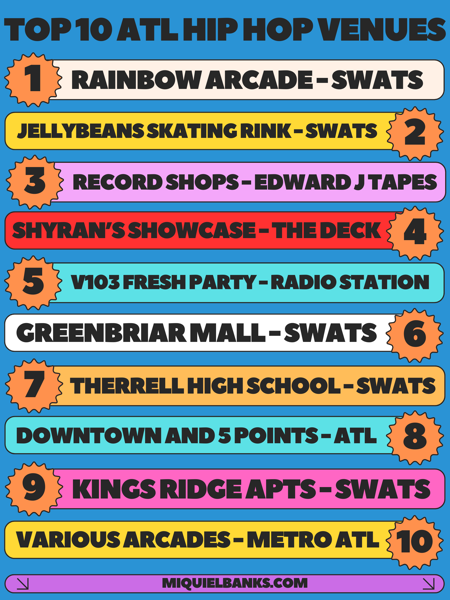Rainbow Arcade – SWATS
The Rainbow Arcade holds the distinction of being Atlanta’s first hip-hop venue, pioneering a counterculture movement that would later be known as Hip Hop.
It quickly became the go-to destination on Friday and Saturday nights, providing a stage for breakdancing crews to showcase their talent and build a vibrant community.
The venue was originally established by Hank Chanson and Wayne Streeter. Later, two brothers, DJ Smash and Kelvin Walton, took the reins, with DJ Smash assuming ownership.
Kelvin Walton joined the team on January 23, 1983, marking the beginning of a new era for the Rainbow Arcade.
Although DJ Smash initially considered renaming the business, the original owners advised him to retain the name “Rainbow Entertainment” to avoid the costs of re-incorporation.
This decision preserved the legacy of the venue while allowing it to evolve under new leadership.
During its tenure, Rainbow was THE SPOT that brought and gave us Hip Hop Music and Hip Hop Culture.
Although an incredible Arcade, it was the Hip Hop Music you heard from DJ Smash that pumped the Spiritual Adrenaline into our Souls.
Long forgotten now, DJ Smash is synonymous with Grandmaster Flowers from the New York Chapter.
And Like Flowers, DJ Smash played all kinds of Hip Hop Music, the B Sides, the C Sides, the D Sides.
He practically invented the concept of going “Into the Crates,” and he was one of the few Professional DJs subscribed to the Million Dollar Record Pool.
I was a Super Regular at Rainbow and I promise you, Smash played Hip Hop Songs that I STILL have not heard to this day.
And for those who think this is a Fluke, think again.
DJ Smash was Self-Taught and he set a record that has not been matched since the Early 80s.
He is the ONLY ATL DJ to win the DJ Competition, not once, not twice, but THREE TIMES IN A ROW.
His Brother, Kelvin Walton, was a legendary Photographer who captured the early scenes of ATL Hip Hop Culture and his Photos are being shared with the world in 2025, look for his Collection, it will definitely RESHAPE and DEFINE the early Days of ATL Hip Hop Culture.
The Rainbow Arcade remained a cornerstone of Atlanta’s hip-hop scene until its closure on January 23, 1985, leaving behind a lasting legacy as the OFFICIAL birthplace of Atlanta’s hip-hop counterculture.
Jellybean Skating Rink – SWATS
Greenbriar Skating Rink / Jellybeans Skating Rink 3850 Stone Rd. SW, Atlanta, GA
I recently came across your page on Greenbriar Skating Rink and wanted to provide some clarity and confirmation regarding its history.
Growing up in the neighborhood during the 1970s and 1980s, I was a regular at the rink and have fond memories of its vibrant atmosphere.
You are correct about the location and the name change.
Originally known as Greenbriar Skating Rink, the venue was renamed Jellybeans during the 1980s.
Part of the confusion surrounding its history stems from the existence of another skating rink also called Jellybeans, located on Roswell Road in the Buckhead area of Atlanta.
Both venues operated concurrently for some time, adding to the mix-up.
It’s possible that the ownership of Greenbriar changed hands, leading to the name change to Jellybeans.
However, this transition occurred after 1981–1982, as it was still operating as Greenbriar Skating Rink during the years I frequented it weekly.
Greenbriar was a hub of community activity and featured an incredible group of skaters who combined artistry and skill, dancing on skates with unmatched talent.
Footage of these performances at Greenbriar exists and is truly a must-watch for anyone interested in the culture and history of skating in Atlanta.
Video Summary
We are taping TV Episodes of “Time-Out” that aired on WSB-TV Channel 2 Atlanta.
The Producer is “Spring Amber.”
Web Links
https://rink-history.weebly.com/greenbriar-skating-rink–jelly-beans-atlanta-ga.html
Record Shops across ATL – King Edward J Tapes
Edward J. Landrum, the man Murder Dog Magazine once named the single “most influential kid in the formation of Atlanta Rap,” opened his first record store in 1980, Landrum’s Records & More.
He was an ambitious salesman, with a degree in advertising and a fully developed alter-ego, King Edward J, for which he paired a smooth-talking proto-rap vernacular with the fashion sense of an unusually hip funeral director (black suits, white ties, black hats).
His series of self-released “J-Tapes,” which were either personalized for the buyer or classified by overriding emotional theme, singlehandedly pioneered the Atlanta mixtape trade in the 1980s, offering the city a foundation on which it could construct a vision of itself as a coherent regional music culture.
Another store, King Edward J Tapes, on Candler Road, soon followed, and became an open market and gathering place for the emergent scene.
An adolescent Killer Mike hitchhiked or rode the bus to buy the latest J-Tape; Young Jeezy just stole them from his older cousins.
Landrum’s in-house DJ Crew, the J-Team, was a kind of super-group of tastemakers and innovative artists who became the standard-bearers for what eventually constituted Atlanta rap, introducing the city to, among many others, Success-N-Effect, the A-Town Players and DJ Smurf (later known as Mr. Collipark).
The first time I called Edward J, one Saturday last summer, he was too busy to talk.
“For the remainder of this afternoon,” he explained, “I will be focusing on my sermon for tomorrow’s service.”
After closing down his last record store in 2002, Landrum had gone into the ministry full-time.
Today, he is a provisional elder in the United Methodist Church.
We spoke recently about his accomplishments, his regrets and his memories of the first Atlanta hip-hop generation.
Link
https://daily.redbullmusicacademy.com/2016/08/king-edward-j-interview
Shyran’s Showcase – Decatur (The Deck)
In 1984, as the world was captivated by the breakdancing craze, Atlanta was making its mark with its own dynamic culture.
The city’s burgeoning hip-hop scene—a vibrant fusion of DJ culture, bass music, yeeking, skate culture, and fashion—laid the foundation for a distinctive movement: Yeeking.
Atlanta’s Influence on Pop Culture
Atlanta has a storied legacy of contributing iconic dances to pop culture, from the Bart (famously performed by Michael Jackson in his 1992 “Remember the Time” video) to the Bankhead Bounce and Soulja Boy’s signature moves.
However, before these phenomena, Atlanta introduced the world to Yeek—the city’s native hip-hop dance legacy.
The Origins of Yeek Yeek was pioneered in 1984 by Anthony Francis and Ron Ron at Westwood High School, where they founded ATL’s first Yeek group, the Fresh Dancing Crew (F.D.C.).
This dance form became a hallmark of Atlanta’s hip-hop identity, evolving through distinct eras:
* The Founders Era (1980–1985)
* The Innovators Era (1985–1990)
* The Prime Era (1990–1995)
* The Bounce Era (1995–2000)
* The Crunk Era (1997–2010)
* The Yeek 2.0/Comeback Era (2022–Present)
What is Yeek?
The name “Yeek” originated from the distinctive call made by onlookers when dancers punctuated their routines with a powerful fourth step.
Yeek was not just any dance—it required skill, precision, and mastery. It wasn’t performed casually in public without rigorous practice and a polished routine.
Unlike most fad dances, Yeek never faded from relevance.
In its heyday during the late 1980s, Yeeking dominated high school talent shows across the city, from Therrell High in the SWATS to Columbia High in Decatur.
Fashion and Culture of the Era
This was also the height of Atlanta’s iconic fashion culture, epitomized by the “Five Points Prep” style, seen prominently downtown near the Five Points MARTA station. Picture this scene:
A young man leans against the wall, his right leg bent and his left flat against it. He’s motionless, his head obscured by a bright yellow fisherman cap. His loose-fitting sky-blue Levi’s and matching yellow T-shirt, layered under an Izod tennis sweater, exude effortless style. His pristine Rod Laver Adidas sneakers, so immaculate they gleam under the dim orange glow of the MARTA station lights, complete the look.
This was Atlanta in its cultural prime—a city where fashion and hip-hop intertwined seamlessly.
Shyran’s Showcase: The Epicenter of Yeeking Battles
At the heart of this vibrant era was Shyran’s Showcase, a legendary teen nightclub located in a strip mall on Gresham Road in Decatur.
By 1989, it had become the undisputed hub for Atlanta’s hip-hop scene, hosting some of the most iconic Yeek battles.
Today, Shyran’s Showcase stands as a cultural landmark, celebrating its 35th anniversary and cementing its legacy in the annals of Atlanta’s hip-hop history.
Links of Note
The History of Yeek Culture
ATL Hip Hop Culture
V103 Fresh Party Radio Station – ATL
In the early days of Atlanta’s hip-hop culture, the only places to experience the music were arcades, talent shows, record shops, or skating rinks.
These venues served as the lifeblood of the culture, providing the sounds and rhythms that defined a generation.
Hip-hop enthusiasts gathered at these spots throughout the week, immersing themselves in the music long before radio stations recognized its influence.
When the radio finally took notice, there was only one station in Metro Atlanta that embraced hip-hop: V-103, with its legendary Fresh Party.
Initially airing for just one hour on Friday and Saturday nights, the Fresh Party became an essential listening experience for the burgeoning hip-hop community.
The overwhelming response from listeners pushed the station to extend the segment to four hours, cementing its place as the heartbeat of Atlanta’s hip-hop scene.
For old-school ATLiens, the Fresh Party holds a special place in history.
It was more than a show; it was a cultural cornerstone that amplified hip-hop’s voice in a city on the rise.
Despite its profound impact, this pivotal moment in Atlanta’s early hip-hop culture often goes unrecognized by those outside the inner circle.
For those who lived it, the Fresh Party remains a defining chapter in Atlanta’s journey to becoming a global hip-hop powerhouse.
Greenbriar Mall – SWATS
Because this Mall was close to Turtle’s and the Rainbow Arcade, it was the PERFECT LOCATION for the Warm-Up to the Intense Breakdance Battles going on at Rainbow.
Our typical day back then was simple.
Get on the bus, the 66 Lynhurst or the 83 Ben Hill, and arrive at the Mall around 2 pm.
Go next door to Turtle’s and listen to the latest Hip Hop Releases.
Leave from there and go to the Gold Mine Arcade.
Sometimes, we’d hit the Movie Theater and if there were rival crews in the area, we had a minor battle downstairs.
After that, we left and went to the Food Court and hung out and pigged out.
Next, we went back to the Gold Mine and around 6 pm, it was SHOWTIME.
Our crews would meet in front of the Gold Mine Arcade and cross Greenbriar Pkwy.
When you enter the Rainbow Arcade, you are met with Dragon’s Lair, Spy Hunter, Dig Dug, Frogger, Defender, and Robotron.
After you walk past the initial games, you are met with a humongous Dance Floor and then, you are hit with the BOOM!
In the back are two HUMONGOUS SPEAKERS and we are hit with DJ Smash scratching and cutting throughout the day.
And for a Breakdancer in a Crew, this is how we live.
We spend all week practicing break moves on Cardboard, listening to our Boom Boxes at home.
Then, we spend Fridays getting our gear ready and rock out to the V103 Fresh Party.
After that, our crew hits Greenbriar Mall, sometimes we watch a movie, sometimes we walk around the Mall talking trash, and sometimes we hit the Gold Mine.
As nighttime comes, we rush across the street to battle rival crews at Rainbow Arcade.
As we battle, DJ Smash hits us with the latest new Hip Hop Songs we have not heard anywhere else.
Every week, DJ Smash receives new records from the Million Dollar Record Pool and we hear Hip Hop Songs that are not heard anywhere else in the City.
Therrell High School – SWATS
Hip-hop culture in the SWATS cannot be discussed without highlighting one of its most iconic hotspots: Therrell High School.
In the 1980s, Therrell High School earns its reputation for two things:
1. Its legendary parties
2. Its unforgettable talent shows
The Therrell parties are powered by two of the most influential DJs in Atlanta’s early hip-hop scene: DJ Chauncey and DJ Toomp.
While DJ Toomp is widely recognized today, DJ Chauncey’s contributions have largely been forgotten—a true shame, as many argue his skills surpassed even those of Toomp.
But that debate is for another day.
Therrell’s talent shows, however, are where history is made.
The most legendary of these takes place in 1985.
Until that moment, two groups dominate the stage: Hot Grits and No Eggs/Broken Arms and Crooked Legs and Kool and Raheem.
Kool and Raheem’s iconic performance features one of the earliest hip-hop songs ever created in Atlanta, “Cause It’s AWESOME!”
Their act electrifies the audience, but their reign is unexpectedly cut short by a groundbreaking force—a new dance crew.
That crew is F.D.C. (Fresh Dancing Crew), and their arrival marks more than just a shift in the talent show. It introduces an entirely new movement: Yeeking.
Fresh off a win at Columbia High School’s talent show, F.D.C. drives across Atlanta, speeding down I-20 and 166, to take the stage at Therrell High School on 3233 Mount Gilead Road.
Their performance not only steals the spotlight but also ushers in a cultural revolution.
For the first time in Atlanta hip-hop history, Yeeking—a dynamic, syncopated dance style—takes center stage.
It’s more than a dance; it’s a phenomenon. In that moment, Yeeking dethrones rapping, breaking, and popping as the hottest trend in Atlanta’s hip-hop scene.
Therrell High School solidifies its place as the birthplace of a movement that forever changes the city’s cultural landscape.
Downtown and 5 Points – ATL
Downtown Atlanta thrives with breakdancing battles, bustling shopping hubs, and high school kids with time to kill.
Yet, it holds an even greater claim to fame as the epicenter of Atlanta’s iconic Five Points Prep—the pinnacle of ATL Hip Hop’s Prep Culture.
The Prep Culture defines the fashion-forward aesthetic of Atlanta’s hip-hop scene, and the Five Points Prep is its most distinguished and visible expression.
Wherever you go in the city—whether hanging out, shopping, or just passing through—you are bound to encounter this subculture.
And when you do, there’s no mistaking it.
Picture this: as you step off the MARTA train and head toward the bus stop, your eyes are drawn to an unforgettable figure standing in a shadowed corner.
He’s posted up against the wall, one leg bent while the other rests flat.
His head is bowed, obscured by a bright yellow fisherman’s cap.
He doesn’t move—almost as if he’s a divine mannequin, frozen in time.
The ensemble is unmistakable.
That yellow cap matches his loose-fitting sky-blue Levi’s and a crisp yellow T-shirt layered under an Izod tennis sweater.
His Rod Laver Adidas sneakers, gleaming white, look pristine, as though they’ve just been unboxed.
The faint orange glow from the MARTA station lights bounces off his shoes, making them seem almost surreal.
You take it all in, but there’s no time to linger—you’re late for the bus.
As you head for the steps, your eyes catch yet another figure across the station.
This time, it’s a man leaning casually against the opposite wall.
His outfit is just as striking: a bright red polo shirt, a red scarf, light-blue Generra pants, and a perfectly matched red Polo belt.
And then, you spot them—his Polo socks and custom-dyed Tretorn sneakers, the exact shade of his pants.
Seriously?
How is this even possible?
You board the bus, but the Five Points Prep culture stays with you.
Toward the back of the bus, you notice another guy clutching the metal pole.
He’s unmistakably part of this underground scene.
He’s wearing Rod Laver Adidas, a tennis sweater casually slung over his shoulders, and—wait—a golf bag?
You stifle a laugh but look closer, realizing he’s carrying an actual tennis racket.
As the bus stops, he steps off and joins a group of similarly styled men—plaid blazers, Sebago loafers, and the confident ease of those who know they’ve nailed the look.
As the bus pulls away, you lean back in your seat and smile.
This is Atlanta.
This is the culture.
This is the A SHAWDY!!!!!
Kings Ridge Apts – SWATS
Kings Ridge Apartments may not be widely remembered, but for those who have lived in the SWATS, its significance is undeniable.
More than just a summer hotspot with its upscale clubhouse and Olympic-sized swimming pools, Kings Ridge Apartments stands as a cornerstone of Atlanta’s hip-hop culture.
Few realize that an estimated 95% of ATL hip-hop’s roots trace back to this area.
Within Kings Ridge itself, several hip-hop legends emerged:
* DJ Stan
* Kool-Ace
* The Great Cheez
* Miquiel Banks
* Da Black Man
Just down the street, the legacy grows with:
* DJ Toomp
* Mike Fresh
* Cooly C
And around the corner, the story continues with:
* Raheem the Dream
* Que Bo Gold
* Ted Rush
Kings Ridge Apartments, along with Campbellton Road and the Greenbriar Mall area, forms the epicenter of ATL hip-hop history.
Its influence resonates throughout the culture, cementing its place as a legendary landmark in the city’s musical and cultural evolution.
Various Arcades across ATL
The 1980s are often celebrated for their cultural milestones, yet the profound impact of arcades on the teenage psyche during this era is frequently overlooked.
In the SWATS, the Gold Mine Arcade served as a hub of activity and creativity.
Downtown, Bumper’s Junction attracted crowds of young people, while in Decatur (“the Deck”), numerous spots offered a haven for arcade enthusiasts.
Arcades were more than just entertainment venues—they were cultural incubators that shaped a generation.
For teens, these spaces provided an escape and a sense of community, where friendships were forged, rivalries played out, and skills honed in games like Ms. Pac-Man, Galaga, Gyruss, Dig Dug, Joust, Defender, and Centipede, and Dragon’s Lair.
But arcades didn’t exist in isolation; they were deeply intertwined with the burgeoning hip-hop culture of the time.
Many of the same youths who spent hours perfecting their gaming skills also immersed themselves in the sounds of DJ Smash, DJ Chauncey, DJ Toomp, King Edward J, DJ Mann, Cooly C, DJ Smurf, and DJ Stan.
The arcade became a place where hip-hop culture—its music, style, and attitude—was celebrated and amplified.
Skating rinks, another major teen hangout of the 80s, often featured arcade games alongside their neon-lit floors.
These venues were cultural crossroads, blending the pulsating rhythms of hip-hop tracks with the competitive energy of gaming.
The fusion of these two worlds helped shape a generation, inspiring fashion, music, and dance moves that would define the era.
The arcades’ influence extended beyond entertainment.
They fostered creativity, competition, and camaraderie—key elements of hip-hop culture.
DJs and breakdancers found inspiration in the flashing lights and electronic sounds, incorporating these elements into their performances and aesthetics.
Today, while the prominence of arcades has faded, their impact on hip-hop culture and the 80s teen psyche remains an indelible part of history.








